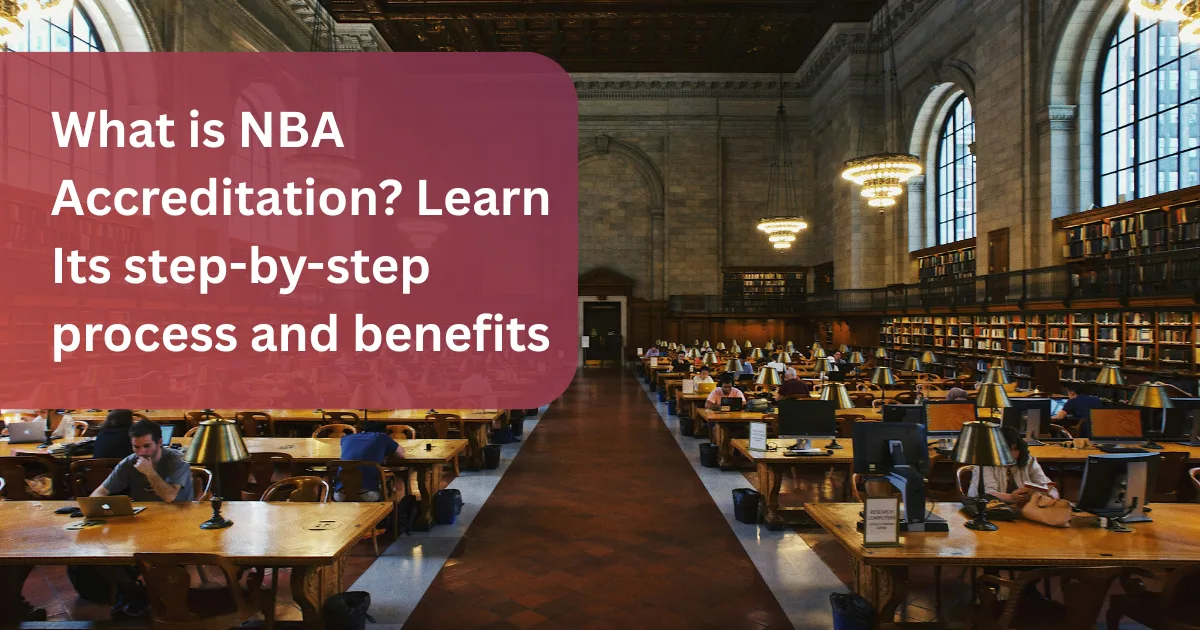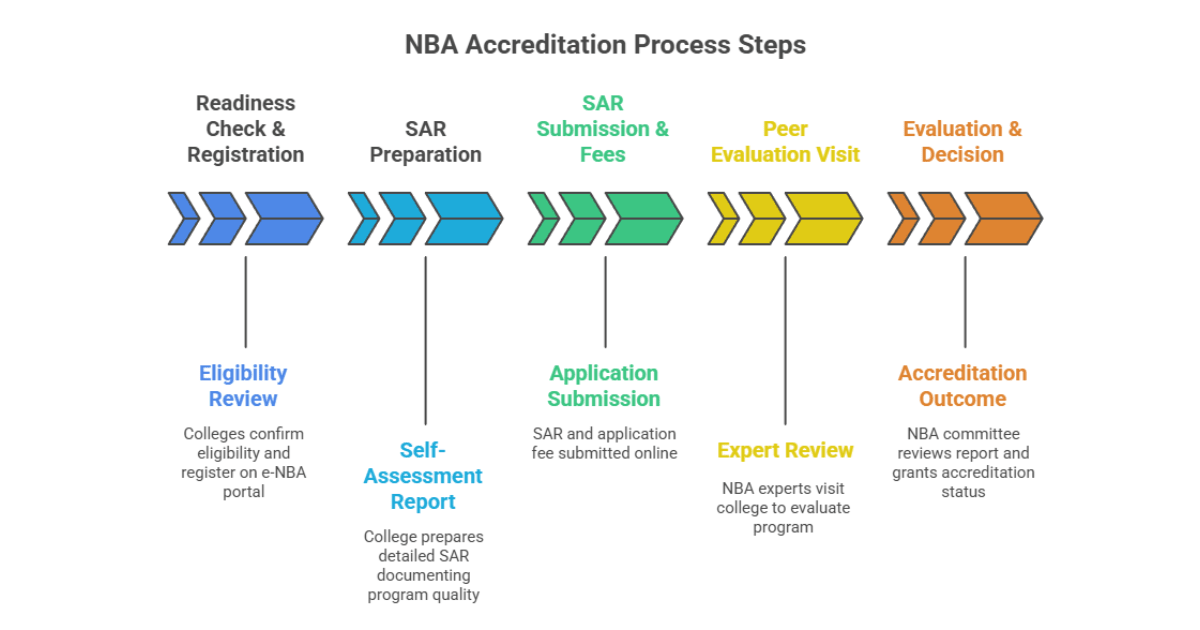What is NBA Accreditation? And its Step-by-Step Process

NBA Accreditation proves that technical programs in India are of good quality. It shows a course that meets clear rules for teaching, lessons, and student success. This is important in India, where thousands of colleges offer engineering and job training degrees.
Getting accredited helps students and parents choose programs they can trust. It also helps colleges stand out, attract funding, and build good reputations. NBA accreditation isn’t just for India. Since the country joined the Washington Accord, approved degrees work in other member countries too. That means better job chances and college options abroad.
What is NBA Accreditation?
NBA Accreditation is run by the National Board of Accreditation (NBA). The board checks if a program meets national and worldwide standards. It looks at teaching, lessons, buildings, and most importantly, what students are able to achieve.
The board covers many areas. NBA accredits programs in engineering, business, pharmacy, architecture, and similar fields. It reviews programs, not whole colleges, so it focuses on specific details.
NBA accreditation is really about making sure quality stays high. It pushes colleges to use Outcome-Based Education (OBE), where success comes from student learning and skills, not just classroom time.
For students, it means better job placement and worldwide opportunities. For schools, it builds trust, good reputation, and chances to work with others.
Why NBA Accreditation Matters
The main goal of NBA Accreditation is to make technical education better in India. It does this by setting clear rules and pushing programs to get better every year.
- Helps Institutions keep improving: Colleges look at their teaching, lessons, and results regularly.
- Focuses on outcome-based education: Institutions care more about what students actually learn and can do.
- Builds trust: Students, parents, bosses, and government can count on approved programs.
- Helps Institutions grow: Getting accredited helps colleges get funding, work with companies, and send students worldwide.
Simply put, NBA accreditation helps everyone: students, schools, employers, and society.
NBA Accreditation Process (Step-by-Step)
The NBA accreditation process is clear and organized. It makes sure every program gets checked for real quality, not just paperwork.

Here’s what happens at each step:
Step 1: Check if Ready & Sign Up
Before applying, Institution must make sure they can qualify. Programs should:
- Be approved by AICTE or another official group.
- Have at least two groups of students who already graduated.
- Have paperwork ready on faculty, infrastructure, curriculum, and outcomes.
Once ready, the institution registers on the e-NBA website, the official online place for applications and documents.
Step 2: Preparation of Self-Assessment Report (SAR)
The Self-Assessment Report (SAR) is the most important part. It’s a detailed document the school prepares that covers:
- Vision, Mission, and Program Objectives (PEOs)
- Curriculum and teaching-learning processes
- Faculty strength, qualifications, and contributions
- Student performance, placements, and achievements
- Infrastructure and learning resources
- Continuous improvement mechanisms
This report shows how well the program follows Outcome-Based Education (OBE). It’s not just about things like classrooms or labs, but about real student results like knowledge, skills, and getting jobs.
Step 3: Submission of SAR and Fees
After preparing the SAR, the institution submits it through the e-NBA portal along with the required fee. NBA then plans the review process.
Step 4: Expert Visit
This is the biggest step. A team of subject experts and experienced teachers visits the institution, usually for 2–3 days. Their job is to check the SAR and see the program up close. During the visit, they:
- Talk with teachers, students, graduates, and employers.
- Look at classrooms, labs, libraries, and computer facilities.
- Check student projects, research work, and testing methods.
- Make sure the school follows AICTE and NBA rules.
- Look for proof of constant improvement and new ideas.
The expert team writes a detailed report with good points, weak spots, and areas to fix.
Step 5: Review & Decision
The expert team’s report goes to NBA’s Academic Advisory Committee. This group looks at the findings, double-checks proof, and makes sure the review was fair.
Based on the review, the program gets one of these results:
- Full Accreditation (for the longest time period)
- Provisional Accreditation (if improvements are needed)
- Denial of Accreditation (if standards aren’t met)
Institutions also get feedback, which becomes a plan for future growth.
Why This Process Matters?
The process isn’t just a checklist. It makes sure that:
- Students graduate with skills bosses want in the real world.
- Institutions use modern teaching methods and digital systems.
- Employers, parents, and government trust program quality.
- Colleges stay matched with worldwide standards like the Washington Accord.
NBA Accreditation Policies and Criteria
NBA accreditation works at the program level, not the whole school level. This means each engineering, business, pharmacy, or architecture program gets checked separately.
Who Can Apply?
- Programs must be approved by AICTE or the right council.
- At least two groups of students should have already graduated.
- Institutions must be in good shape with money and academics.
SAR Submission Rules:
Colleges must write a Self-Assessment Report (SAR). It includes information on teachers, lessons, buildings, research, job placement, student results, and how the school runs. Being honest and clear is important since checkers will look for proof.
How Experts Check Programs?
- A team of expert checkers visits the school for 2–3 days.
- They make sure SAR details are true, talk with teachers, students, and graduates, and look at buildings.
- Checking follows a criterion-wise scoring system (covering vision, faculty, student performance, governance, research, and industry engagement).
- Final scores decide if the program gets accreditation for 3 years (provisional) or 6 years (full accreditation).
NBA Accreditation Criteria:
- Outcome-Based Curriculum.
- Outcome-Based Teaching-Learning.
- Course Outcomes (COs) and Program Outcomes (POs).
- Students’ Performance.
- Faculty Information and Contributions.
- Facilities and Technical Support.
- Continuous Improvement
- Student Support and Governance
Learn about NBA Accreditation SAR 2025 vs 2015 comparison criteria wise in detail here.
Outcome-Based Education (OBE) Approach in NBA
Before 2009, India’s accreditation was input-based. Focus was on classrooms, libraries, and how many teachers there were. But worldwide standards wanted more.
Now, NBA focuses on Outcome-Based Education (OBE). The change is from what teachers teach to what students actually learn and use.
Student Skills Measured in OBE:
- Knowledge: Subject skills, problem-solving, and research abilities.
- Skills: Talking, teamwork, creativity, and design thinking.
- Actions: Right and wrong choices, caring about the environment, and helping society.
Why OBE Is Important?
- Employers want graduates who can use knowledge, not just pass tests.
- Worldwide recognition depends on results, which match with the Washington Accord.
- OBE gets students ready for a digital, creative world and makes Indian programs compete worldwide.
Benefits of NBA Accreditation
For Institutions:
Getting accredited builds trust. It shows that a program meets national and worldwide quality rules. Accredited programs attract better students, get funding chances, and open doors to work with companies and other countries.
For Students:
Students win big. They get better job chances, since companies trust approved programs. Their degrees work worldwide under the Washington Accord, making it easier to go to college or get jobs in other countries.
For Teachers:
Teachers in Accredited programs stay excited about their work. Getting accredited requires ongoing teacher training, research, and new ideas. This creates more chances for job growth, meetings, and working with others.
For Everyone:
Accreditation makes sure schools produce better quality graduates. These graduates create new things, start businesses, and help the environment, making society better for everyone.
Why NBA Accreditation Matters?
The main reason for NBA accreditation is making quality better. It makes sure Institutions don’t stay the same but change with worldwide standards and what companies need.
Big Changes:
- Better Quality Programs: Institutions use ongoing internal checks, feedback systems, and digital tools.
- More Students: Students choose Accredited programs, leading to better admissions and stronger classes.
- Better Reputation: Accredited institutions get higher rankings and stronger reputations, both in India and worldwide.
- Policy Support: Accreditation directly helps the goals of the National Education Policy (NEP) 2020 and the United Nations Sustainable Development Goals (SDGs) by focusing on fairness, job skills, and worldwide standards.
Conclusion:
NBA accreditation isn’t just about following rules. It represents real change in how colleges teach, test, and get students ready for the future.
The long-term good things are clear:
- Institutions gain trust and growth.
- Students get better job chances and worldwide opportunities.
- India makes its education system stronger.
Time to Act: Schools must start writing their Self-Assessment Reports (SAR) and use digital tools for better tracking and matching goals. The sooner colleges take action, the stronger their advantage in the years ahead.
Need Help with NBA Accreditation?
Kramah Software offers AI-powered accreditation solutions tailored for NBA Accreditation.
Book a Demo Now to see how we simplify compliance and reporting.
Quick Summary
NBA accreditation is a quality stamp by India’s National Board of Accreditation for technical programs like engineering, business, pharmacy, and architecture. It makes sure colleges follow results-based learning, meet worldwide standards under the Washington Accord, and improve student job chances, school trust, and worldwide recognition.
References & Further Reading
- Official NBA Resources: Manuals, SAR guidelines, and FAQs available at NBA India Website.
- NEP 2020 Framework: Ministry of Education, Government of India.
- Washington Accord: Details at the International Engineering Alliance (IEA) website.
- Expert Insights: Blogs, webinars, and analysis by education leaders such as Deepesh Divakaran.
Frequently Asked Questions
(FAQs)
